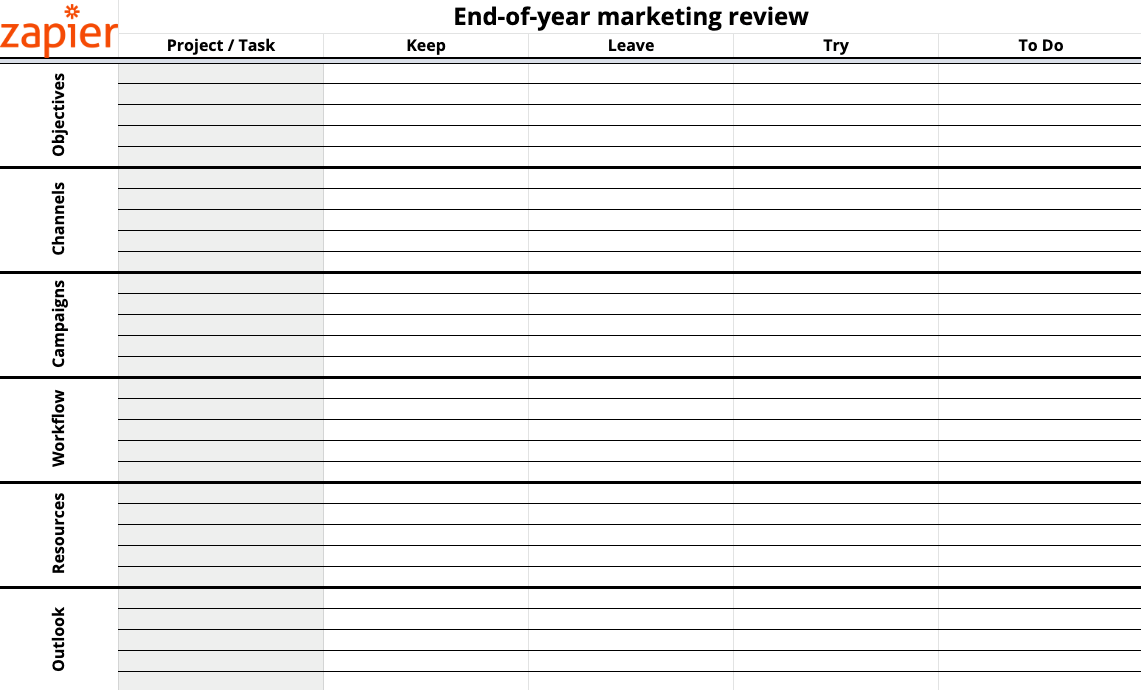Ah, another year is coming to a close.
Wait, another year is coming to a close?!
Believe it or not (I personally refuse to believe), the end of the year is rapidly approaching. That means it's time to reflect on the previous 12 months of work in preparation for doing it all again. I've found that it's best to have some structure in place for your end-of-year review, though, or else you'll get mentally sidetracked or overwhelmed (or both).
It's also possible to keep year-end marketing audits simple. You don't need a bunch of time or fancy tools—just a place to jot down your thoughts. I even made a simple marketing review template to get you started.
So, let's take a trip down memory lane to make sense of your marketing work.
The components every marketing audit needs
There's a time and place to reflect and sit with your thoughts and feelings. But for now, we want to review with a purpose. Every marketing audit needs to leave you with a sense of what to:
Keep: Find what worked, so you can do more of it
Leave: Find what didn't work, so you can stop wasting time
Try: Assess how you might correct course or try new things
So, we look at everything about our work for the year and analyze it with the same set of questions.
What did you do?
What worked?
What didn't work?
What do you want to try next year?
What's next?
In the marketing audit template, there are columns for each of these review questions.
As you move through the different areas of your work and evaluate them against these questions, you may find you don't have answers to all of them. That's ok! All you need to do is use these questions as thought starters to keep your audit moving forward.
6 areas to include in your annual marketing audit
Marketing is much more than the final deliverables that your audience sees. Rather than gauging the past year's success on metrics or marketing goals alone, it's helpful to take a holistic approach to everything you've done.
There are six areas I recommend auditing.
Make a copy of this marketing audit template, and take a look at the second sheet (labeled "Sample") to see an example of a completed review.
1. Objectives
Chances are you and your team had goals this year, so go ahead and start your review from the top. Think about what your goals were, who set them, and whether you met them. You could have a mix of company-wide initiatives, marketing-specific benchmarks, and even personal work goals.

2. Channels
Next, reflect on your marketing channels, content distribution, and promotional strategy. Any key project that deals with getting marketing in front of your audience goes in this section. You can also include any co-marketing or cross-promotion projects.

3. Campaigns
Now take time to consider your marketing deliverables for the year. What projects or overarching campaigns did you tackle? Did you try any new formats, styles, or tones? If you created something this year, you could reflect on it here.

4. Workflow
Now that you've audited customer-facing work and goals, it's time to turn your attention inward. Consider how you managed projects this year, both within your team and across the organization. Think about every step in your workflow, from ideation through creation and into analysis. You just might find a few steps in your workflow you can automate to save time next year.

5. Resources
You may or may not have much sway over your department's budget or staffing for the upcoming year. Still, you can't advocate for yourself and your team if you aren't aware of issues. Use the fifth section of the audit to make a note of any staffing, time management, or tools that were wins or challenges this year.

6. Outlook
Finally, don't forget about the mental and emotional well-being of the team. Write down any relationship or culture projects you tried. This section is also perfect for logging professional growth or earning initiatives, like conferences or continued education.

Small improvements lead to big change
There can be a tendency to embrace "new year, new me" to an extreme degree, but significant changes aren't always sustainable. Rather than taking on too many updates at once, use this review process to find a few minor improvements you can try. You can always keep a backlog of ideas, but you're more likely to stick to your upward course through a few incremental improvements.






